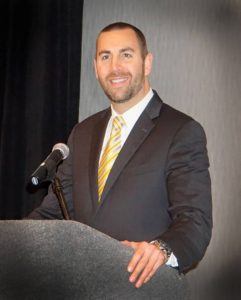Property/casualty insurance executives may be worried about disrupters discovering novel ways to connect with their hard-earned policyholders, but an insurance regulator with a reputation for jumpstarting change sees positive motivations for industry action on the horizon.
“What they’re really doing is they are forcing the industry to be very honest with itself, look itself in the mirror and say, ‘We had better meet this challenge. We had better figure out what our policyholders want. We better get from point A to point Z, or we are going to lose them,'” North Dakota Insurance Commissioner Adam Hamm told Carrier Management in a September interview.
Asked about the creation of InsurTech competitors that include peer-to-peer insurers, on-demand coverage providers and underwriting platforms using social networking reputations instead of credit scores, Hamm delivered two calls to action. “It incentivizes the insurance industry to stay on the top of its game. And it incentivizes us as regulators to do the same thing” and to work with the industry, he said.
 “We have the largest, most competitive insurance market on planet Earth. If we want to stay there, then we are all going to have to figure out ways to deal with these disrupters.”
“We have the largest, most competitive insurance market on planet Earth. If we want to stay there, then we are all going to have to figure out ways to deal with these disrupters.”“If we don’t do that as regulators, then the industry is going to suffer, which is only going to hurt the insurance sector as a whole, including our insurance regulatory system,” he said. “We have the largest, most competitive insurance market on planet Earth. If we want to stay there, then we are all going to have to figure out ways to deal with these disrupters.”
Hamm, who has served as North Dakota’s commissioner for the past nine years and on a national level at the National Association of Insurance Commissioners—as president in 2014 and as chair of the Cybersecurity Task Force for the past two years—is actually not personally staying in either of those regulatory roles. With his term as commissioner coming to an end this year, Hamm decided not to seek re-election. (See related article, “What’s Next for N.D. Insurance Commissioner Adam Hamm?“)
Republican Jon Godfread won the election for insurance commissioner last month and will assume the position in 2017.
Looking ahead, what does Hamm view as the biggest challenges ahead for his soon-to-be-former peers involved in state regulation?
Top of mind for Hamm is cybersecurity. “That is something the insurance sector has to get right. We have to get to a point where we’re doing everything we can to stop these breaches from occurring—and when they are occurring, stopping the bleeding as quickly as possible.
Bigger picture, Hamm has advice for the industry overall—not just regulators but every part of the insurance ecosystem, including insurance companies and agents: “We have to come back to proving our value add,” he said.
Focusing on state regulators specifically, he said: “The federal government is becoming more and more involved in insurance because internationally, through the IAIS [International Association of Insurance Supervisors], they’re becoming more involved in trying to set standards that can apply across the globe. As state insurance regulators, we have to recommit to proving what our value add is to this regulatory process so that we continue to have an NAIC for another 145 years ….
We have to prove every single day why the state insurance regulatory system is better than having the federal government do it, and better than having international standards become required in the states. In other words, we have to show that we’re not only protecting consumers but that we’re being flexible enough to meet the needs of the insurance industry from a regulatory perspective, and that we’re doing all of this in a way that is being done in a consistent and basically uniform way across the United States.Making a related point, Hamm spoke about the disrupters that are emerging. “The insurance industry is getting all sorts of pressure to figure out ways to meet the needs and expectations of consumers of today.” As they engage in insurance transactions, “they want it right now, they want it seamless—and in some ways it’s really not where insurance has been for the last few decades.
“You’re starting to see peer‑to‑peer, Lemonade, the list goes on and on” of companies transforming the insurance buying process to match customer expectations. “To meet the needs of their consumers, the industry is going to need help from regulators in order to get from point A to point Z,” he said.
“For my colleagues, we have to commit ourselves to think outside of the box to make sure that the insurance industry is continuing to be competitive, is continuing to be the sort of industry that’s going to attract consumers to want to participate in it while at the same time complying with insurance regulatory laws, rules, and requirements.
“That is a needle that has to be threaded,” he said, noting that as the insurance industry strives to become more front-facing with consumers, some of the initiatives really don’t fit within the insurance regulatory paradigm in place today.
“How do we figure out a way to crack the nut of making it so that the consumer is getting what they need while at the same time regulators are still in a position to protect them,” he asked, summing up the key challenge.
(In a longer version of this article, Hamm also reflects on his nine-year tenure and talks about how the department beat some long odds to open up the state’s health insurance market, offering a lesson learned from the experience that applies directly to the current landscape of disruption. In the profile article, which was also published in Carrier Management magazine, he also discusses a leadership style that emphasizes consensus-building.)
***
Related Videos:
- Regulator’s Viewpoint: Do Regulators Get in the Way of Innovation?
- Why Insurance Regulators Care About Cybersecurity
- Cyber Could Kill the Insurance Industry: Insurance Commissioner Hamm
- North Dakota Insurance Commissioner Adam Hamm Looks Back
Related Articles:





















 Why ‘Good Enough’ Is Killing Insurance: The Hidden Cost of Satisficing
Why ‘Good Enough’ Is Killing Insurance: The Hidden Cost of Satisficing  Underwriter, Actuary Fears of AI Drop; Work Needed on Collaboration
Underwriter, Actuary Fears of AI Drop; Work Needed on Collaboration  Five AI Trends Reshaping Insurance in 2026
Five AI Trends Reshaping Insurance in 2026  First Atlantic Hurricane Forecast for 2026 Suggests Season Close to 30-Year Norm
First Atlantic Hurricane Forecast for 2026 Suggests Season Close to 30-Year Norm 






